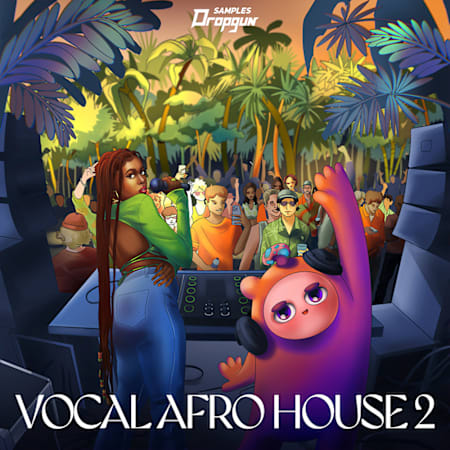/fszplpykfkdgeagmorrz)
In the world of Afro House, vocals carry a deep emotional weight—blending power, rhythm, and vulnerability in equal measure. Drogun Samples returns with South African artist and vocalist Maline Aura for Vocal Afro House 2, a sample pack rooted in soul, clarity, and versatility. In this interview, Maline opens up about her recording process, vocal production techniques, and the creative mindset behind crafting vocals for both traditional tracks and sample packs. Whether you're a producer looking to bring more life into your toplines or a vocalist searching for workflow inspiration, Maline drops gems on every question.
Our Interview with Maline Aura
Splice: What’s your typical setup for recording high-quality vocals (microphone, pre-amps, room treatment, etc.)?
Maline Aura: For me, getting high-quality vocals starts with having the right mic for the voice. I usually go for something like the Neumann TLM 103 for its clarity or the Shure SM7B if I want a warmer, more intimate sound. A solid preamp is essential—I like using the Universal Audio Apollo Twin for its clean yet warm character. As for room treatment, I make sure the recording space is well-treated with acoustic panels and bass traps to minimize reflections. I love natural room temperature unless the weather outside is too hot then I’d set the room temperature to be at 16 degrees C, of course switching it off occasionally so my voice is not affected when I record. A pop filter, isolation shield, and high-quality headphones like the Audio-Technica ATH-M50x also help ensure the best possible take for myself.
S: What’s your approach to vocal production? Do you focus on getting a perfect take or prefer to experiment with different takes and comp them later?
MA: I like to capture the best possible take in the moment, but I always record multiple takes for flexibility. Sometimes the magic is in the little imperfections, so I encourage experimenting with different deliveries and tones. Later, I comp the best parts together to create a performance that feels both polished and natural. Emotion always comes first—I’d rather have a raw, powerful take than a technically perfect but lifeless one.
S: What are some processing techniques you commonly employ when producing vocals for a sample pack? Do you have any favorite plugins or a go-to chain that serves as a starting point?
MA: Firstly I must mention that i use Logic to record my vocals and that’s because I feel its the best because of its amazing precision. When working on vocals for a sample pack, I focus on making them as clean and versatile as possible. My usual vocal chain starts with stacking my vocals to keep everything tight without making it sound robotic. Stacking helps me amplify my phrases so that they sound strong and bold. With the help of the Dropgun team engineer, I sent them just clean well recorded raw vocals and they did the magic of mixing them to what they are now.
S: How does the topline, adlib, or one-shot creation process for a sample pack differ from a more traditional songwriting session?
MA: With a traditional songwriting session, you’re telling a story—the lyrics, melodies, and emotions all work together to create a complete piece. But with sample packs, every vocal element needs to be usable in different musical contexts. That means making sure toplines are catchy but not too specific, adlibs have character but stay flexible, and one-shots are crisp and clean for easy manipulation. It’s more about versatility and sound quality than lyrical depth.
S: What are some of your favorite vocal recordings? What vocalists, songwriters, and/or engineers inspire you?
MA: I’m inspired by artists who know how to use their voice as an instrument. Frank Ocean’s vocal layering and raw emotion are incredible. Beyoncé’s technical precision and control are next level. I also admire Samthing Soweto from South Africa and a young lady named Thando Zide who from them I got inspired to focus more on my tone and delivery when recording. I love how all these artists experiment with their vocal textures. On the production side, guys like Drega (SA) , Ryan Murgatroyd really influence the way I approach vocal mixing and production.
S: Are there any other tips, best practices, philosophies, etc., around vocal production that you’d like to share?
MA: One thing I’ve learned is that a great vocal take starts with the right mindset. If the artist isn’t feeling comfortable, it’s going to show in the recording. So I always make sure the vibe in the studio is relaxed. Another big tip is to use automation—volume rides, EQ sweeps, and reverb automation can really bring a vocal to life. And finally, don’t over-process. If the raw take already sounds good, don’t overthink it. Sometimes, simple is better.
/sgmv0skel4jf2rqd53vb)
/bqx5g1apatnal80r0snc)
From selecting the right mic and curating the perfect vibe to her thoughts on vocal stacking and emotional delivery, Maline Aura offers a thoughtful, experience-rich look into her vocal process. Her emphasis on versatility, clarity, and emotion is reflected throughout her newest sample pack, Vocal Afro House 2. Whether you're building grooves from scratch or layering in that final vocal sparkle, her voice is here to elevate your sound.


